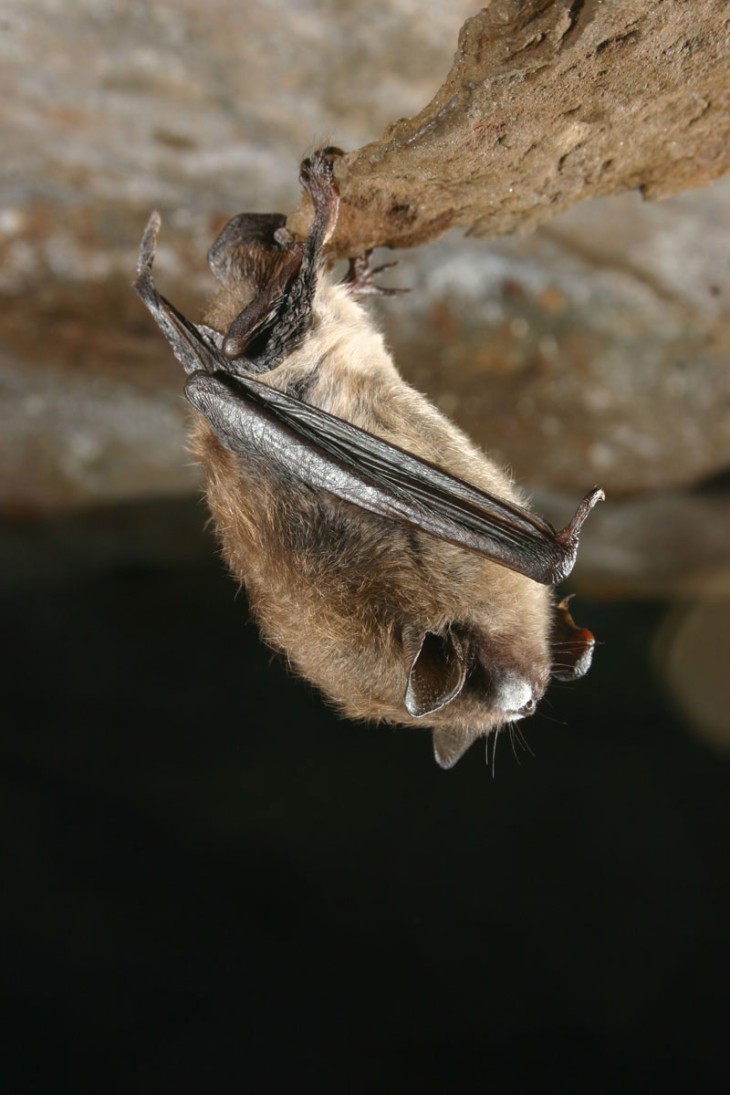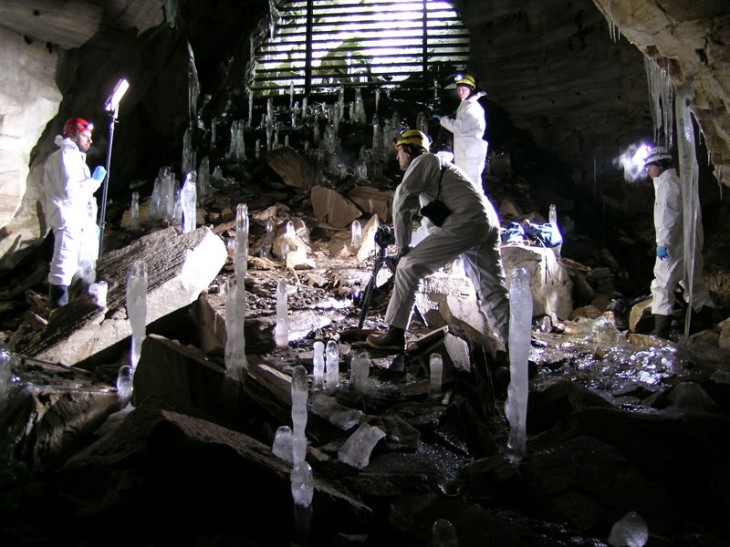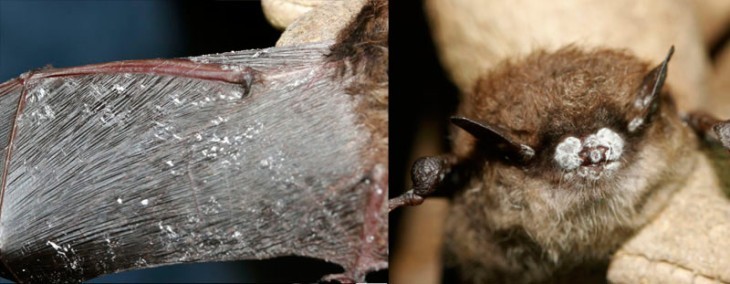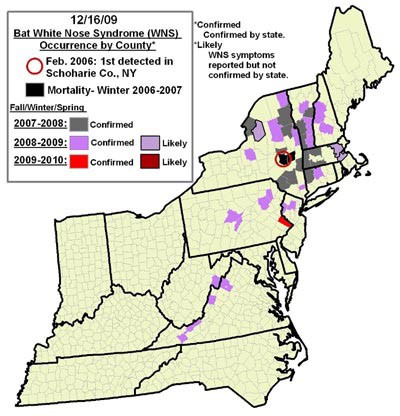If this story were a movie, it might best begin with a flashback. After the opening credits, perhaps backed by an ominous soundtrack, we’d be transported back two years, to a happier time before white-nose syndrome had wiped out roughly 90 percent of the local bat population.
It is September 2007, and Scott Darling, the bat biologist for Vermont’s Fish & Wildlife Department, is leading a group of 20 bat enthusiasts, including me, up a steep, mile-long trail. It’s a warm autumn evening, and we’re venturing to the Mount Aeolus bat cave in Dorset, Vermont, the largest known bat hibernation site in all of New England. About 23,000 bats have been counted hibernating there.
At an overlook on the trail, Darling gives us a lesson on bats. He says that despite their reputation, bats are not flying mice; in fact, they’re more closely related to primates. He explains that a female bat rears just one pup per year and can live 20-30 years. He says that there are nine species of bat in Vermont. (New York has the same nine species; the other New England states have eight, lacking the Indiana bat.) Six of these species are called “cave bats,” because they spend their winters hibernating in caves and mines. The other three species are called “tree bats,” and they migrate as far south as Mexico to spend the winter in warm places where bugs are still flying.
We reach the cave opening just as darkness falls. About a dozen bats swirl overhead.
This is a mating swarm, Darling explains. The bats meet and mate on autumn evenings near hibernation sites. One of Darling’s assistants scoops a bat from the swarm with a net. Darling holds the bat, spreading its wings to show how it is made up of a membrane of skin stretched across delicate hand-bones, how its teeth are tiny, but pointy to catch insects, how the intricate folds of skin on its nose and ears likely aid echolocation.
One woman asks if she can touch the bat. “Well, you could,” Darling replies, “but then I’d have to kill it.” He explains that about one-half of one percent of all bats carry rabies. Darling has been inoculated, but public health protocol demands that any bat that comes in contact with an un-vaccinated human be killed and tested.
In groups of about five, members of the expedition accompany Darling into the mouth of the cave where we sit on rocks in front of a bat gate. The gate’s metal slats keep human visitors out while allowing the bats to fly freely. The bats are more concentrated in this entryway, weaving among us, sometimes brushing close enough that we can feel the breeze from the down-flap of their wings on our cheeks.
There are no squeals at these close encounters - these are bat enthusiasts, after all. Most in attendance already know that the bats will not get tangled in our hair, that echolocation allows them to navigate the darkest night with precision, just as their excellent eyesight lets them see in the daytime.
As we leave, maybe 80 bats flit over the cave entrance. “This may be the top wildlife experience in the state of Vermont,” Darling said.
The Syndrome Strikes
Today, this experience no longer exists. White-nose syndrome has killed more than a million bats in the Northeast in the past two years. Today, Darling visits the Mount Aeolus cave only for research. There are no field trips to the cave, and it is closed to recreational cavers. It is no longer a place of wonder.
White-nose syndrome was first discovered in Hailes Cave, found dead and dying, their faces and wings dusted with a white, powdery fungus. Soon, dead bats were found in 18 other sites in the area. Initially, biologists thought it was a regional problem restricted to bats in the Albany area.
Five months later, this thinking changed. Darling got a phone call at home from New York State Department of Environmental Conservation wildlife biologist Al Hicks. A caver had discovered white-nose syndrome at Morris Cave in Danby, Vermont, less than 10 miles from Mount Aeolus. This was a big leap in the spread of the disease. Morris Cave is nearly 50 miles from the epicenter of the caves previously known to be affected, and is in a different state, which adds to the complexity of managing the situation.
Within months, the syndrome was discovered at bat hibernation sites in Massachusetts, Connecticut, and New Hampshire as well. White-nose syndrome had quickly become a regional problem.
Darling immediately began a systematic search of Vermont’s known bat hibernation sites to check for white-nose syndrome. He left Morris Cave for last. If something contagious were causing the syndrome, he didn’t want to spread it to other Vermont caves.
On February 14, 2008, Darling returned to the Mount Aeolus bat cave, this time with a Vermont Fish and Wildlife staffer and Peter Youngbaer, a caver active in many caving organizations who had helped Darling with cave work at Mount Aeolus in the past.
It was a cold, sunny day, Youngbaer reports. As the three men donned white haz-mat suits at the end of the trail to the cave, they noticed bats flying around. This was not a good sign. While bats may rouse briefly during hibernation, and may even fly around on warm, winter days when there are flying insects about, there were no flying insects for these bats to eat on this cold day. The bats were using up the energy reserves they had built up to last through the whole winter.
Before the team even unlocked the bat gate, Youngbaer says, they counted 85 bats huddled in crevices outside the cave and several dead bats lying in the snow. Another bad sign. As they explored the cave, the usually agile bats would sometimes crash into them. The men would gently remove the bats from their protective suits and allow them to grasp the cave wall with their feet, where they would cling, safe for the moment. Without traveling very deep into the cave, the team found another 25 dead bats and 50 bats clearly stricken with white-nose syndrome - white fungus on their wings, ears, or faces. The team did not have to search farther. [Editor’s note: watch video of bat biologists exploring infected bat caves, at the U.S Fish & Wildlife’s Northeast Region webpage.]
A Fungus That Prefers the Cold
What followed was a frantic scrambling within the biology community to figure out what, exactly, this white-nose affliction was. Darling took many trips to Mount Aeolus that winter to collect data. Al Hicks and his staff were collecting similar samples from affected caves in New York, and other scientists were doing the same work in Connecticut, Massachusetts, and New Hampshire. Darling collected bat guano for a study on contaminants and guided a scientist who took scrapings from the cave wall for an environmental study.
But mostly Darling and the other scientists collected dead bats, packed them in ice, and shipped them to various labs. Many of those bats wound up at the U.S. Geological Survey’s National Wildlife Health Laboratory in Madison, Wisconsin. There, microbiologist David Blehert was trying to get to the bottom of the many mysteries surrounding the white fungus. While the white noses were the most obvious symptoms of the fungus, the fungus isn’t a symptom; scientists initially had reason to believe that it wasn’t the primary cause of the bat deaths. Fungal infections rarely kill mammals, but they often take advantage of animals whose immune systems are already weak from disease, starvation, or some other cause. And one thing all of these bats had in common was very little or no body fat. They had starved to death.
When Blehert found the same, previously unknown whitenose fungus on 10 bats in different caves in different states, the idea that the syndrome was indeed caused by the fungus suddenly became more likely.
Blehert’s further study showed that the mysterious fungus grows best at cold temperatures, about 41-50°F and doesn’t grow at all at temperatures over 68°F. He found that it was most closely related to a group of soil fungi that often grow in caves, in the genus Geomyces.
Working with other scientists at the National Wildlife Health Lab, he found that this fungus was dermatophyte, a fungus that grows on skin, like athlete’s foot or ringworm. The Wildlife Health Lab researchers saw, however, that this fungus was not stopping at the outermost, dead layer of skin like those infections do but was burrowing deep into the bats’ living lower layer of skin.
With this discovery, the mystery of white-nose syndrome made a little more sense. When they hibernate, bats lower their body temperatures to within a degree or two of the temperature of the cave. For bats at the Mount Aeolus cave, and other northern hibernation sites, these temperatures are often a little over 40°F, the perfect growing temperature for the fungus that has now been named Geomyces destructans.
Only the Northeast’s hibernating bats - the little brown bat, the northern myotis, the big brown bat, the Indiana bat, the eastern pipistrelle (once known as the tricolored bat), and the small-footed bat - have been seen with the fungus. This may be because their body temperature drops low enough for the fungus to take hold. The tree bats that migrate south in winter - the silverhaired, red, and hoary bats - have not been seen with the fungus.
A cold-loving fungus as a cause of the syndrome could also explain why people seem not to be affected, even the cavers who had stumbled into infected caves unprotected, and why no other animals, from the dogs and cats that live near affected caves to the raccoons and weasels that feast on the dying bats, have shown any symptoms or effects.
Most scientists familiar with the syndrome now believe that the fungus is the cause, but research continues as they work out the details. For example, it is not known exactly how the fungus kills the bats. Some scientists believe that the fungus irritates the bats to death. Athlete’s foot can be itchy, even painful. Every time a bat scratches, or tries to groom the fungus away, it must rouse from hibernation and use up fat stores that will just barely allow it to live until spring under the best conditions. Because they are waking much more frequently than normal, they burn away their fat reserves and starve to death before flying insects return to the landscape to feed them.
Further studies are needed to prove this hypothesis, however. A stricken cave in New York State that still has bats hibernating in it was outfitted with video cameras last winter so that scientists could observe the bats throughout the winter without otherwise disturbing them.
Other studies are being conducted to unravel some of the fungus’s remaining mysteries. A study in Vermont is testing how the fungus is spread - is it strictly from bat to bat, or does the cave itself become infected? Healthy bats from a robust population in Wisconsin were brought to an infected mine in Vermont, with many precautions taken to assure that the bats didn’t escape from the Vermont mine and fly back to Wisconsin. (The precautions included a series of three framed-in screens, each with its seams sealed with spray-foam insulation.)
In the lab, scientists are investigating the fungus’s origins. Bats with a similar, fuzzy white fungus on their wings and faces have been seen in Europe, but the fungus does not appear to kill bats there. Is it the same fungus reacting differently in different species of bats? Has the fungus mutated? Or is it a completely different organism? A genetic analysis of the North American fungus and the European fungus should show the relationship between them.
Right now, Blehert and other scientists suspect that most of the spread of white-nose syndrome comes when the fungus is transmitted from bat to bat. Bats mix and mingle while mating, while hibernating, and while raising their young in maternity colonies. But people likely play a small but significant role in the syndrome’s spread.
It might have been a human, possibly a caver, who brought the fungus from Europe to North America on contaminated clothing or gear. People have the potential to spread the fungus between regions by hopping on a plane or driving a car. For this reason, hibernation sites throughout the eastern half of the country have been closed to cavers, although commercial caves remain open, since people are unlikely to have contact with bats there.
The Natural Consequences
By May 2009, white-nose syndrome had been confirmed not only in New York, Vermont, Massachusetts, Connecticut, and New Hampshire but also in New Jersey, Pennsylvania, West Virginia, and Virginia. Losses of 60-90 percent of the bats in each affected cave means that most of the hibernating bats in the northeastern United States have died in the last several years. Bats are not a well-studied group of animals, and no one knows for sure what their loss will mean. One thing seems likely - there will be more bugs. Bats weighed before and after their night-time foraging runs have been found to be up to 50 percent heavier after they’ve eaten, meaning that the bats eat up to 50 percent of their weight in insects each night.
While much has been written about an impending mosquito boom, the effect of fewer bats on local mosquito populations is not clear. “Bats are key consumers of moths and beetles,” says Darling. Mosquitoes are too small to be worth the effort of hunting them, at least most of the time, Darling believes. “People say the mosquito populations will change because of the bats, but I think it’s more likely that moth and beetle populations will change.”
Could the loss of these bats lead to an increase of forest pests like gypsy moths and forest tent caterpillars? Forest insect pest expert Douglas Allen, Professor Emeritus of Environmental and Forest Biology at Syracuse University, says that it is unlikely that bats eat gypsy moths. “The female moth does not fly and males are active only during the day.” He says that bats almost certainly eat the moths of forest tent caterpillars.
He also says, however, that bats eat so many different species of flying insects that their impact on the population of any one species is unlikely to be significant.
None of the bat species found in the Northeast is expected to go extinct immediately due to white-nose syndrome, because all the species that live around here are widespread elsewhere in North America. The same is not true, however, for bats in other areas of the country. The Virginia big-eared bat hibernates in only five caves in Virginia, West Virginia, and North Carolina. Last winter, white-nose syndrome was confirmed in a cave close to a known Virginia big-eared bat hibernation site.
Wildlife managers fear that the syndrome will continue to spread south and west to the huge bat hibernation sites in Kentucky, Tennessee, Indiana, and neighboring states. These caves hold millions of bats each and are home to complex ecosystems that operate completely in the dark.
Will shorter winters, and warmer caves mean that white-nose syndrome will be less devastating in the South? Wildlife managers can only wait and watch to find out. If the syndrome spreads to that region of the country, and proves to be as lethal as it is in the Northeast, the Ozark big-eared bat, one of the rarest mammals in North America, will also be at risk of extinction.
Bats of the Northeast
Migrating
- Silver-haired Lasionycteris noctivagans
- Red Lasiurus borealis
- Hoary Lasiurus cinereus
Year-round residents
- Northern long-eared Myotis septentrionalis
- Little brown Myotis lucifugus
- Indiana Myotis sodalis (federally endangered)
- Eastern pipistrelle (tricolored) Perimyotis subflavus
- Big brown Eptesicus fuscus
- Small-footed Myotis leibii
A Silent Spring
In our region, it’s possible that the disappearance of bats from our landscape won’t be noticed by the average person. After all, our region has lost, or nearly lost, animal species in the past. Turkeys and beavers came back. Passenger pigeons and heath hens did not.
But scientists worry that the bat’s problems are part of a larger decline in ecosystem health. One important aspect of white-nose syndrome, Darling points out, is that it is only one of several slights our local environment has suffered in the last several years. White-nose syndrome has been compared to the decline of amphibians and colony collapse disorder in honey bees. “The parallels are scary,” he says.
Darling compares these events to potholes in our ecological infrastructure. Just like a highway, he says, there are only so many the system can bear before it crumbles. “I’d like to be optimistic for bats, but it’s harder to by the day,” says Darling. There is more than our region’s bats at stake, he says. “The lesson is not just about bats, but how we take care of these ecological potholes.”






Discussion *